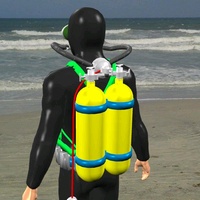
"Twin-hose" open-circuit scuba
This is the first type of diving demand valve which came into general use, and the one that can be seen in classic 1960s SCUBA adventures, such as TV`s Sea Hunt.
In this type of set, the two (or occasionally one or three) stages of the regulator are in a large circular valve assembly mounted on top of the cylinder pack. This type has two wide breathing tubes like those on many modern rebreathers, one for intake and one for exhalation. The return tube was not for rebreathing, but because the air exhaust needed to be as near as possible to the regulator`s second stage diaphragm, to avoid pressure differences, which would cause a free-flow of gas, or extra resistance to breathing, according to the diver`s orientation in the water: head-up, head-down, level. In modern single-hose sets this problem is avoided by moving the second-stage regulator to the diver`s mouthpiece. The twin-hose sets came with a mouthpiece as standard, but a fullface mask was an option. Another optional extra was a mouthpiece that also had a snorkel attached and a valve to switch between aqualung and snorkel.
Note the correct layout of this type in the image. In comics there have been thousands of drawings of two-cylinder twin-hose aqualungs shown wrongly, with one wide breathing tube coming straight out of each cylinder top with no regulator.